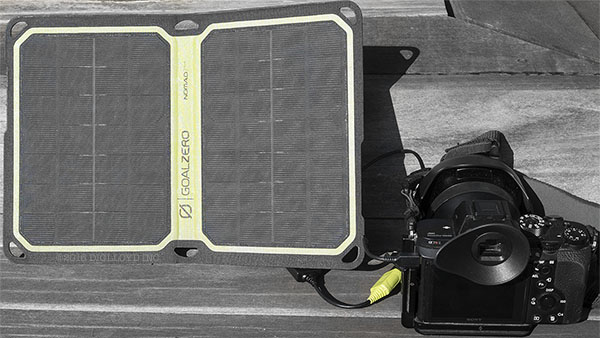REVIEWED: GOAL ZERO Yeti 15 Solar Battery Pack and Nomad 7, Nomad 20 Solar Panels
See my solar and battery power charging wish list at B&H Photo.
About a year ago, I wrote Up in the Mountains in a Canyon, What to do for Power for a Laptop?.
I’ve now had a chance to test several Yeti Goal Zero solar power products first hand.
- GOAL ZERO Yeti 150 Solar Generator Power Pack
- GOAL ZERO Nomad 7 Plus Solar Panel
- GOAL ZERO Nomad 20 Solar Panel
- GOAL ZERO Lighthouse 250 LED Lantern / USB Charger
- Wagan Pure Sine Wave Power Inverter for AC power in Car/SUV/boat
- Charging Cameras, iPhone, iPad, USB Devices: Lupine USB One
Sony cameras like the Sony A7R II are terrific in that off-grid most all of them can be direct-charged through the USB port on the camera, a boon for backpackers and similar. But there is no such option for Nikon or Canon or Pentax DSLRs, or the Hasselblad X1D, so to solar charge, that means first charging a battery pack that has an AC inverter in it—uggh! It’s yet another reason that Sony would be my go-to camera for backpacking or similar. But see not from Jonathan D below.

Jonathan D writes:
It appears that DC-only chargers for the Nikon EL15 battery do exist. To wit:
Newmowa Dual USB Charger for Nikon EN-EL15 @AMAZON
Neewer USB Battery Charger for EN-EL15 @AMAZON
Though not at tidy as charging directly in-camera, these do appear to avoid the inherent inefficiencies of AC-DC conversion.
...
these third-party DC chargers only have two contacts (a positive and negative terminal) where they interface with the battery. The original AC chargers (Nikon MH-25a for instance) have five, suggesting some missing charging protocols on the DC units.
I'd probably use them with third-party/generic EN25 batteries (Polaroid- or STK-branded) before trying them out on the $48 Nikon OEMs. Doesn't matter to me terribly if they slowly degrade the former, so long as it doesn't start a fire. Reviews of both chargers suggest they're perhaps just reliable enough.
DIGLLOYD: it means carrying another bulky item—and the whole idea is that one is off the grid, presumably with a backpack, so weight and space count for a lot. With Sony, one tiny cable is all that's needed. The other issue is voltage and amperage regulation and how it might degrade or damage a “smart” battery. Who knows what those chargers do to battery life and such.
Don’t rule out fires—LiIon batteries are not to be messed around with. I once used CR123A batteries in a flashlight that were allegedly decent, and they just about melted my flashlight.
Peter H writes:
This Anker PowerPort Solar Lite @AMAZON from Anker looks impressive in the review at OutdoorGearLab.com.
That said, for the week-long wilderness walks I do, I prefer the dependability of a powerbank. I use the Anker PowerCore 10000 to recharge my A7R II, headlamp, phone and Steripen.
Not as bomb-proof as a Lupine with a USB ONE no doubt, but when you're already carrying 30kg, every gram counts (and the Anker only weighs 170g).
DIGLLOYD: Amazon carries the 15W PowerPort Solar Lite @AMAZON, which looks to provide much more charging power than the GOAL Zero Nomad 7 and at less than half the price and about the same weight. I have not yet tested it, but I plan to do so. What I have not verified (inquiry pending) is whether the PowerPort Solar Lite charges the Anker PowerCore 20100 @AMAZON battery.
Then there are the Anker PowerCore @AMAZONbatteries in 10000, 13000 and 20000 mAH and other capacities. The Anker 20000mAh Portable Charger PowerCore 20100 @AMAZON looks most appealing to me, but the smaller sizes are appealing to, depending on size/weight/power needs. The Anker PowerCore 26800 @AMAZON is even more substantial, but it probably makes more sense to go with dual PowerCore 20100 units for more power and the ability to carry only one (smaller) unit when both are not needed. As yet I have not tested these products or determined how faster or efficient solar charging is.
The difference between these USB charger style batteries and the Yeti power packs is several:
- The Anker batteries (and many other brands) are designed for USB charging only, no AC or 12V DC out.
- The Anker 20100 offers dual high power USB ports (can charge dual iPads!).
- The Anker batteries are highly portable.
- The Anker batteries are useless for powering a MacBook Pro Retina because the laptop has no power-in from USB.
- The Anker units are LiIon (not lead acid), so they weigh much less per Ah.
- The Anker batteries take about 11 hours to charge, even using AC (very slow).
Note that if you use a Lupine headlamp (or bike light), the Lupine USB One is even more attractive: the same battery for the headlamp can be used to charge a phone or tablet or camera. But the Lupine batteries are not solar chargeable.
I wrote to Anker, and it turns out that their panels should work for direct USB charge, but are not viable for charging the Anker batteries:
In fact, we would not suggest our customer to use solar charger to charge high capacity battery such as 20100mA. Please allow me to explain why. For the solar charger, it requires a very restrict working environment, it has to be under the direct sunlight (usually the best sun for a day is from 12-4). But to fully charge your 20100mAh battery pack even with a normal 5V/2A AC adapter it will need 10-11 hours. You will not be able to charge your battery fully in one time at all. But the solar charger Lite should work for your cameras if the input for your cameras are within 5V/2.4A.
Here’s the challenge: if I go out for the day, I’d like to leave a solar panel charging a battery (I want to use the camera!). The 168 Wh GOAL ZERO Yeti 150 charged fully in 2 days (see review linked above), and has about 50% more capacity than the Anker 20100 mAh battery, so it looks like good 'ol lead acid is the right solution for
Mark H writes:
As it happens, I've just returned from 19 days of backpacking in the Sierra with the a7r. As you mention, one of the reasons that I brought the Sony was because I could recharge batteries through the USB connection that's built into the camera.
I used the LightSaver USB Roll-up Solar Charger and Battery Bank @AMAZON and found it to work well when attached to the top of the backpack, as long as [1] I was above timberline for most of the day or [2] I was careful to set out the panel when arriving in camp.
DIGLLOYD: looks like another option. Nothing like field use to test things out.
See also:
- Charging iPhone, iPad, any USB-Chargeable Device: Lupine USB One
- Sony A7R II: Field Charging the In-Camera Battery
- Power On the Road: Power Inverter for Everything, MagSafe Charging for Apple Laptops
- USB-Charging your iPad, iPhone, Cameras in the Car, Colored Lightning Cables
- MagSafe Connector Disconnects? Fix it with the NewerTech Snuglet
- Flashlights and Headlamps
- Staying Warm, Dry, Safe


























